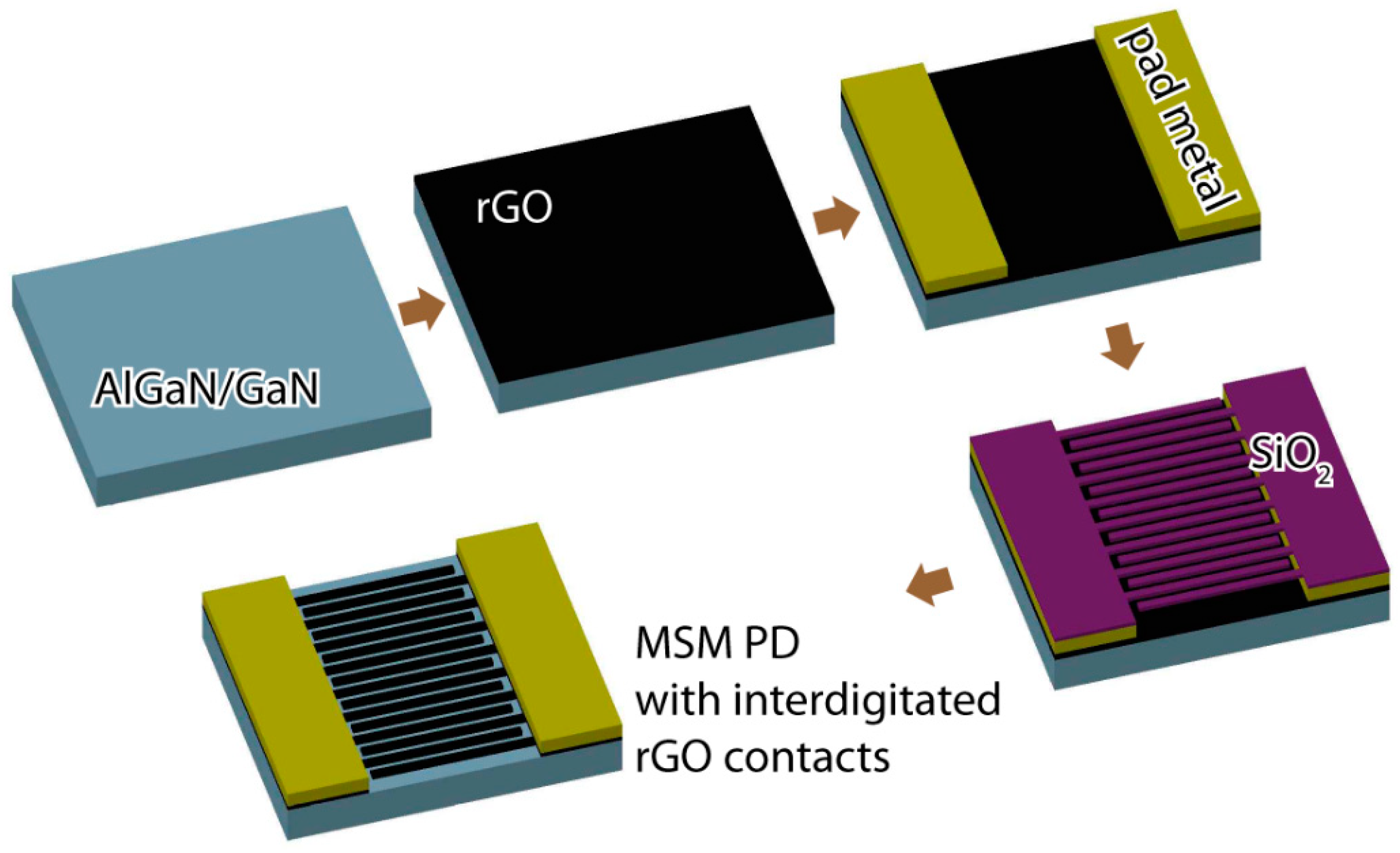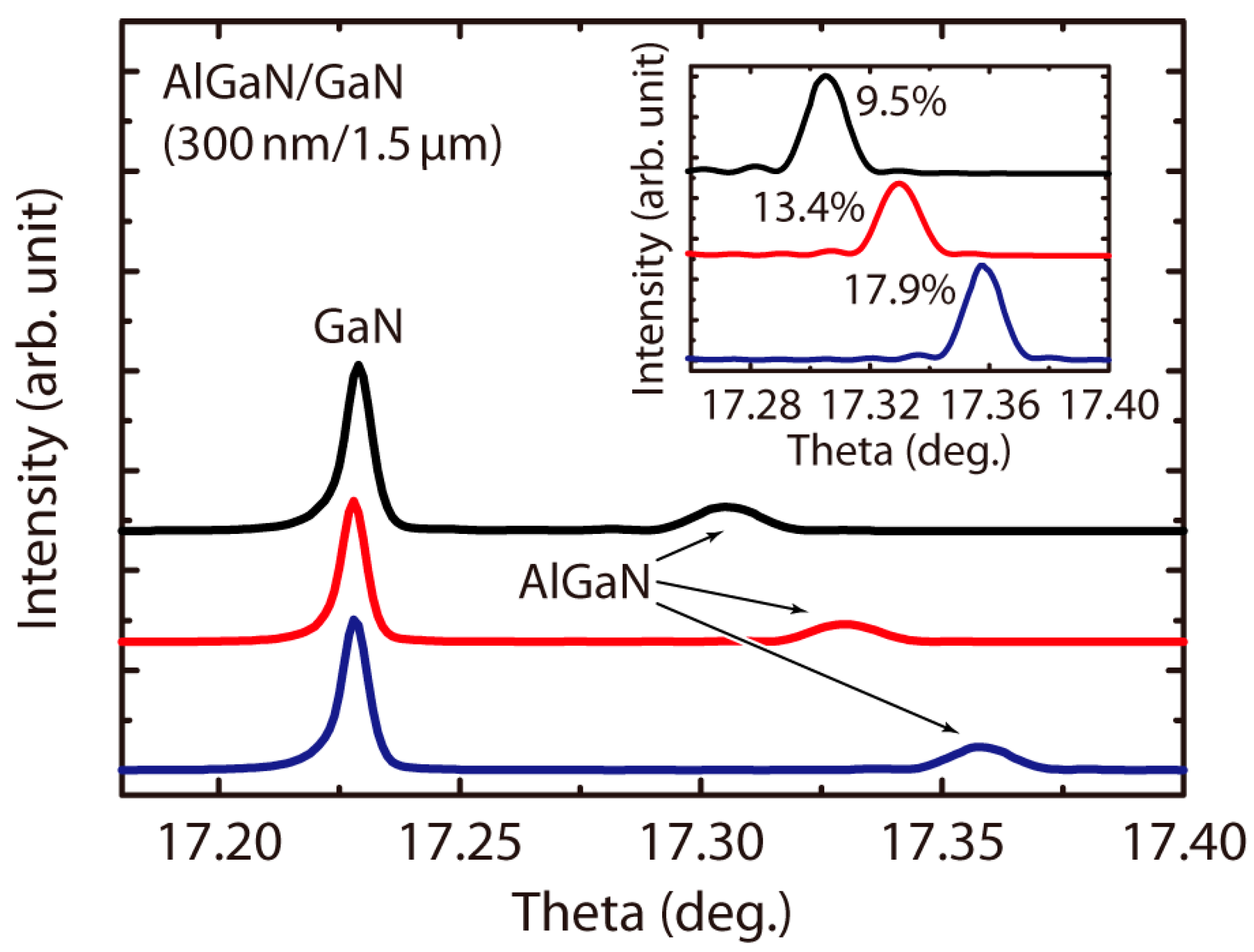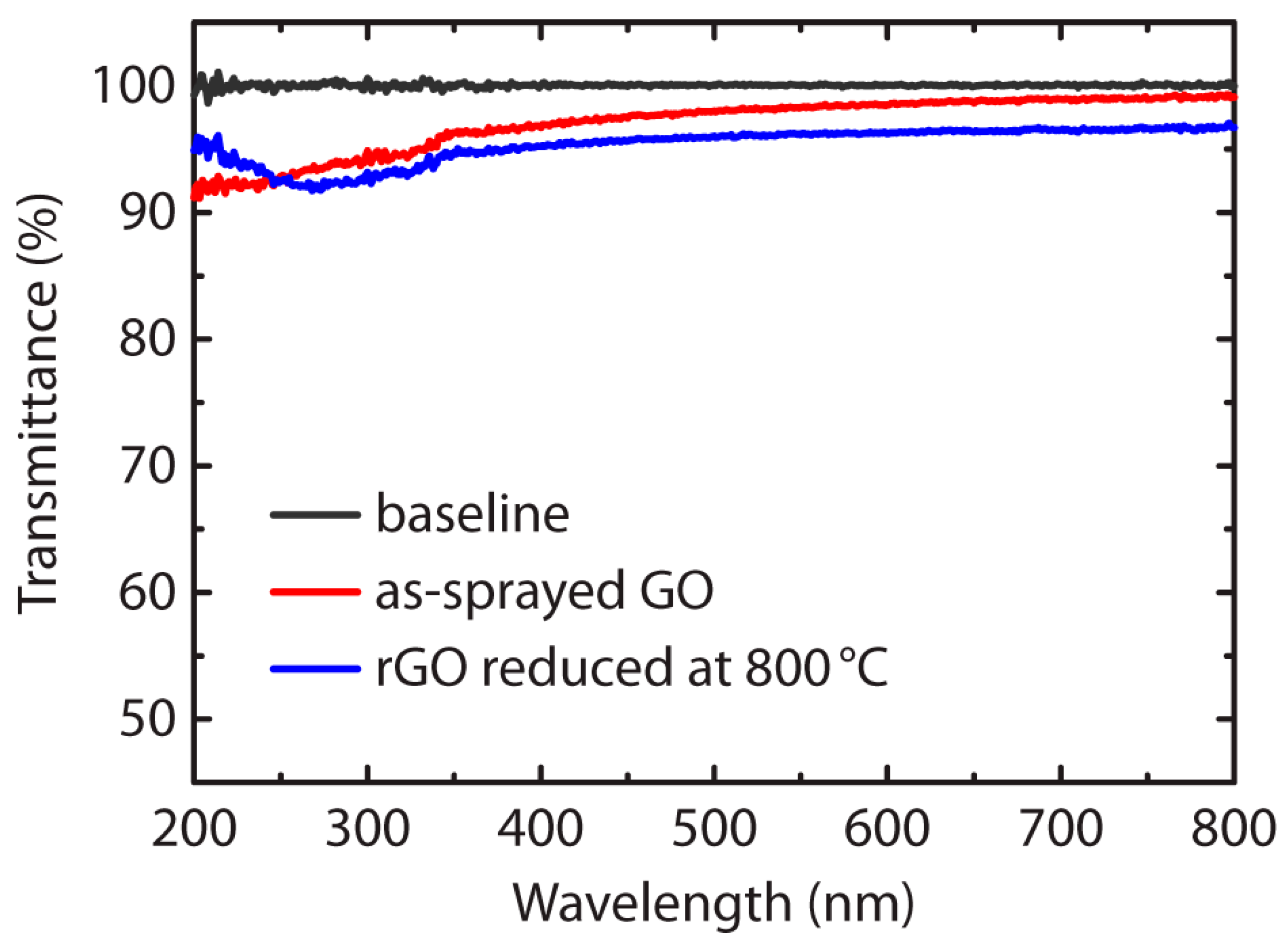AlGaN Ultraviolet Metal–Semiconductor–Metal Photodetectors with Reduced Graphene Oxide Contacts
Abstract
1. Introduction
2. Materials and Methods
3. Results and Discussion
4. Conclusions
Author Contributions
Funding
Conflicts of Interest
References
- Khan, A.; Balalrishnan, K.; Katona, T. Ultraviolet light-emitting diodes based on group three nitrides. Nat. Photonics 2008, 2, 77–84. [Google Scholar] [CrossRef]
- Khan, A.M.; Shatalov, M.; Maruska, H.P.; Wang, H.M.; Kuokstis, E. III–Nitride UV Device. Jpn. J. Appl. Phys. 2005, 44, 7191–7206. [Google Scholar] [CrossRef]
- Mishra, U.K.; Parikh, P.; Wu, Y.F. AlGaN/GaN HEMTs—An Overview of Device Operation and Applications. IEEE Trans. Electron. Devices 2002, 90, 1022–1031. [Google Scholar] [CrossRef]
- Sang, L.; Liao, M.; Sumiya, M.A. Comprehensive Review of Semiconductor Ultraviolet Photodetectors: From Thin Film to One-Dimensional Nanostructures. Sensor 2013, 13, 10482–10518. [Google Scholar] [CrossRef] [PubMed]
- Monroy, E.; Omnès, F.; Calle, F. Wide-bandgap semiconductor ultraviolet photodetectors. Semicond. Sci. Technol. 2003, 18, R33–R51. [Google Scholar] [CrossRef]
- Schreiber, P.; Dang, T.; Pickenpaugh, T.; Smith, G.; Gehred, P.; Litton, P. Solar blind UV region and UV detector development objectives. Proc. SPIE 1999, 3629, 230–248. [Google Scholar]
- Razeghi, M.; Rogalski, A. Semiconductor ultraviolet detectors. J. Appl. Phys. 1996, 79, 7433–7473. [Google Scholar] [CrossRef]
- Walker, D.; Zhang, X.; Saxler, A.; Kung, P.; Xu, J.; Razeghi, M. AlxGa1−xN (0 ≤ x ≤ 1) ultraviolet photodetectors grown on sapphire by metal-organic chemical-vapor deposition. Appl. Phys. Lett. 1997, 70, 949–951. [Google Scholar] [CrossRef]
- Carrano, J.C.; Grudowski, P.A.; Eiting, C.J.; Dupuis, R.D.; Campbell, J.C. Very low dark current metal–semiconductor–metal ultraviolet photodetectors fabricated on single-crystal GaN epitaxial layers. Appl. Phys. Lett. 1997, 70, 1992–1994. [Google Scholar] [CrossRef]
- Qi, L.; Mok, K.R.C.; Aminian, M.; Charbon, E.; Nanver, L.K. UV-sensitive low dark-count pureB single-photon avalanche diode. IEEE Trans. Electron. Devices 2014, 61, 3768–3774. [Google Scholar] [CrossRef]
- Berger, P.R. Metal-semiconductor-metal photodetectors. Proc. SPIE 2001, 4285, 198–207. [Google Scholar]
- Bonaccorso, F.; Sun, Z.; Hasan, T.; Ferrari, A.C. Graphene photonics and optoelectronics. Nat. Photonics 2010, 4, 611–622. [Google Scholar] [CrossRef]
- Becerril, H.A.; Mao, J.; Liu, Z.; Stoltenberg, R.M.; Bao, Z.; Chen, Y. Evaluation of solution-processed reduced graphene oxide films as transparent conductors. ACS Nano 2008, 2, 463–470. [Google Scholar] [CrossRef] [PubMed]
- Pei, S.; Cheng, H.M. The reduction of graphene oxide. Carbon 2012, 50, 3210–3228. [Google Scholar] [CrossRef]
- Tu, N.D.K.; Choi, J.; Park, C.R.; Kim, H. Remarkable Conversion between n- and p-Type Reduced Graphene Oxide on Varying the Thermal Annealing Temperature. Chem. Mater. 2015, 27, 7362–7369. [Google Scholar] [CrossRef]
- Zhu, M.; Li, X.; Guo, Y.; Li, X.; Sun, P.; Zang, X.; Wang, K.; Zhong, M.; Wu, D.; Zhu, H. Vertical junction photodetectors based on reduced graphene oxide/silicon Schottky diodes. Nanoscale 2014, 6, 4909–4914. [Google Scholar] [CrossRef] [PubMed]
- Li, G.; Liu, L.; Wu, G.; Chen, W.; Qin, S.; Wang, Y.; Zhang, T. Self-Powered UV–Near Infrared Photodetector Based on Reduced Graphene Oxide/n-Si Vertical Heterojunction. Small 2016, 12, 5019–5026. [Google Scholar] [CrossRef] [PubMed]
- Pandit, B.; Cho, J. Metal–semiconductor–metal ultraviolet photodiodes based on reduced graphene oxide/GaN Schottky contacts. Thin Solid Films 2018, 660, 824–827. [Google Scholar] [CrossRef]
- Hummers, W.S., Jr.; Offeman, R.E. Preparation of Graphitic Oxide. J. Am. Chem. Soc. 1958, 80, 1339. [Google Scholar] [CrossRef]
- Vegard, L. Die konstitution der mischkristalle und die raumfüllung der atome. Z. Phys. 1921, 5, 17–26. [Google Scholar] [CrossRef]
- Liou, B.T.; Yen, S.H.; Kuob, Y.K. Vegard’s law deviation in band gaps and bowing parameters of the wurtzite III-nitride ternary alloys. Proc. SPIE 2005, 5628, 296–305. [Google Scholar]
- Mahata, M.K.; Ghosh, S.; Jana, S.K.; Chakraborty, A.; Bag, A.; Mukhopadhyay, P.; Kumar, R.; Biswas, D. Comprehensive strain and band gap analysis of PA-MBE grown AlGaN/GaN heterostructures on sapphire with ultrathin buffer. AIP Adv. 2014, 4, 117120. [Google Scholar] [CrossRef]
- Pandit, B.; Jo, C.H.; Joo, K.S.; Cho, J. Changes in physical properties of graphene oxide with thermal reduction. J. Korean Phys. Soc. 2017, 71, 156–160. [Google Scholar] [CrossRef]
- Ryu, B.D.; Hyung, J.H.; Han, M.; Kim, G.S.; Han, N.; Ko, K.B.; Kang, K.K.; Cuong, T.V.; Hong, C.H. Long-term stability of Si-organic hybrid solar cells with a thermally tunable graphene oxide platform. RSC Adv. 2016, 6, 73242–73250. [Google Scholar] [CrossRef]
- Ravikiran, L.; Radhakrishnan, K.; Dharmarasu, N.; Agrawal, M.; Wang, Z.; Bruno, A.; Soci, C.; Lihuang, T.; Ang, K.S. GaN schottky metal–semiconductor–metal UV photodetectors on Si (111) grown by ammonia-MBE. IEEE Sens. J. 2017, 17, 72–77. [Google Scholar] [CrossRef]
- Wickenden, D.K.; Bargeron, C.B.; Bryden, W.A.; Miragliotta, J.; Christenmacher, T. High quality self-nucleated AlxGa1−xN layers on (00.1) sapphire by low-pressure metalorganic chemical vapor deposition. Appl. Phys. Lett. 1994, 65, 2024–2026. [Google Scholar] [CrossRef]
- Ochalski, T.J.; Gil, B.; Lefebvre, P.; Grandjean, N.; Leroux, M.; Massies, J.; Nakamura, S.; Morkoç, H. Photoreflectance investigations of the bowing parameter in AlGaN alloys lattice-matched to GaN. Appl. Phys. Lett. 1999, 74, 3353–3355. [Google Scholar] [CrossRef]
- Kumar, M.; Jenong, H.; Polat, K.; Okyay, A.K.; Lee, D. Fabrication and characterization of graphene/AlGaN/GaN ultraviolet Schottky photodetector. J. Phys. D Appl. Phys. 2016, 49, 275105. [Google Scholar] [CrossRef]
- Xu, K.; Xu, C.; Xie, Y.; Deng, J.; Zhu, Y.; Guo, W.; Xun, M.; Teo, K.B.K.; Chen, H.; Sun, J. Graphene GaN–based schottky ultraviolet detectors. IEEE Trans. Electron. Devices 2015, 62, 2802–2808. [Google Scholar] [CrossRef]





© 2018 by the authors. Licensee MDPI, Basel, Switzerland. This article is an open access article distributed under the terms and conditions of the Creative Commons Attribution (CC BY) license (http://creativecommons.org/licenses/by/4.0/).
Share and Cite
Pandit, B.; Cho, J. AlGaN Ultraviolet Metal–Semiconductor–Metal Photodetectors with Reduced Graphene Oxide Contacts. Appl. Sci. 2018, 8, 2098. https://doi.org/10.3390/app8112098
Pandit B, Cho J. AlGaN Ultraviolet Metal–Semiconductor–Metal Photodetectors with Reduced Graphene Oxide Contacts. Applied Sciences. 2018; 8(11):2098. https://doi.org/10.3390/app8112098
Chicago/Turabian StylePandit, Bhishma, and Jaehee Cho. 2018. "AlGaN Ultraviolet Metal–Semiconductor–Metal Photodetectors with Reduced Graphene Oxide Contacts" Applied Sciences 8, no. 11: 2098. https://doi.org/10.3390/app8112098
APA StylePandit, B., & Cho, J. (2018). AlGaN Ultraviolet Metal–Semiconductor–Metal Photodetectors with Reduced Graphene Oxide Contacts. Applied Sciences, 8(11), 2098. https://doi.org/10.3390/app8112098





